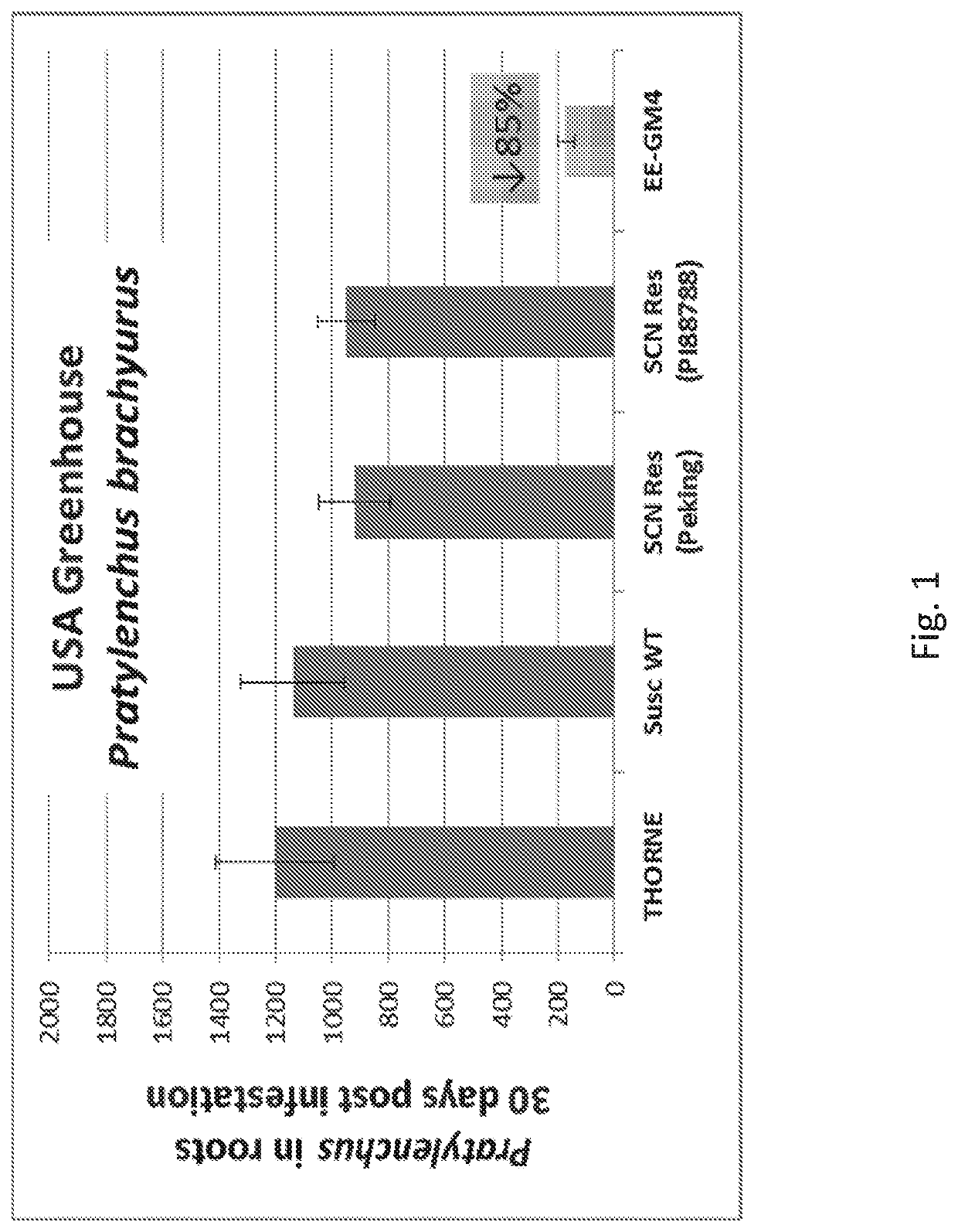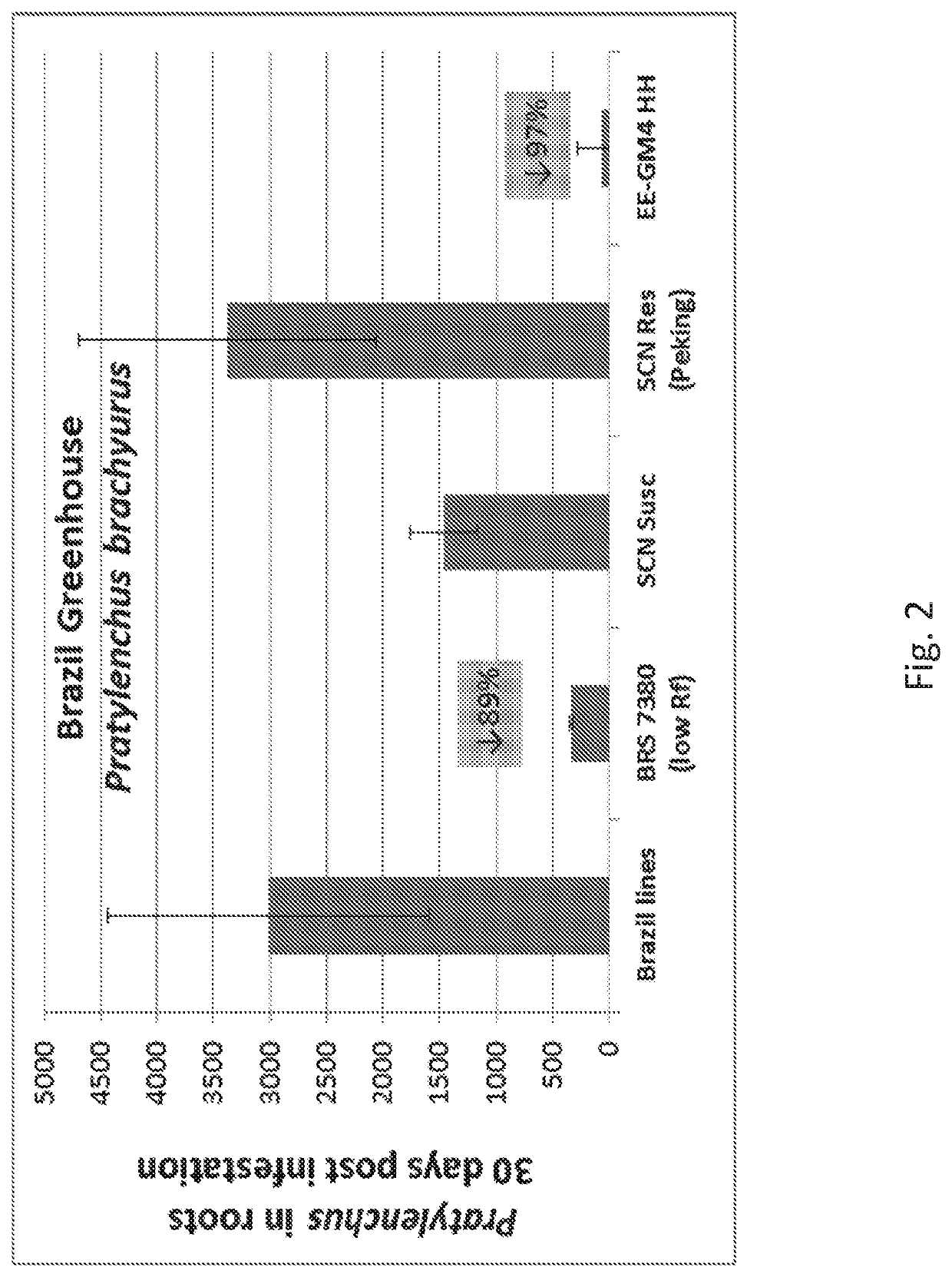Use of cry14 for the control of nematode pests
a technology of nematode pests and cry14, which is applied in the field of molecular biology, can solve the problems of low yield or death, disruption of the vascular system of the plant roots, and the greatest damage of the nematode in soybeans, and achieve the effect of increasing the yield of the plant and enhancing the nematod
- Summary
- Abstract
- Description
- Claims
- Application Information
AI Technical Summary
Benefits of technology
Problems solved by technology
Method used
Image
Examples
experimental examples
Example 1. Cry14Aa1 Expression in Soybean
[0118]Soybean events expressing Cry14Aa1 (SEQ ID NO:3) were developed through Agrobacterium-mediated transformation of Thorne soybean plants using a construct containing a gene encoding a 4-hydroxyphenylpyruvate dioxygenase protein (HPPD) inhibitor tolerant herbicide gene (described in WO02014043435) and Cry14Aa1. Wild-type Thoeme soybean served as the non-nematode resistant control. Cry14Aa1, when expressed in soybean plants, reduces the number of Pratylenchus brachyurus that reproduce in the roots compared with wild-type plants. Three independent event lines consistently gave the same result showing nematode reduction upon retest multiple times. In all three events, the number of nematodes was reduced by 60-85%.
example 2
Expression in Soybean
[0119]EE-GM4 soybean events expressing Cry14Ab1 (SEQ ID NO:4) were developed through Agrobacterium-mediated transformation of Thoeme soybean plants using a construct containing a gene encoding a 4-hydroxyphenylpyruvate dioxygenase protein (HPPD) inhibitor tolerant herbicide gene (described in WO2014043435) and Cry14Ab1. Wild-type Thorne soybean served as the non-nematode resistant control. Cry14Ab1, when expressed in soybean plants, reduces the number of Pratylenchus brachyurus that reproduce in the roots compared with wild-type plants. Non-transformed Thorne and EE-GM4 seeds were geminated and planted in the greenhouse to check for control of the lesion nematode, Pratylenchus brachyurus. Pratylenchus brachyurus nematodes (#1500 / plant, different developmental stages) were applied to the plants when 2 weeks old. Thirty days after application, Pratylenchus nematodes were extracted from the roots and counted. The average number of nematodes found in the roots of pl...
example 3
of Genes for Plant Expression
[0123]The coding regions of the invention are connected with appropriate promoter and terminator sequences for expression in plants. Such sequences are well known in the art. Techniques for producing and confirming promoter-gene-terminator constructs also are well known in the art.
[0124]In one aspect of the invention, synthetic DNA sequences are designed and generated. These synthetic sequences have altered nucleotide sequence relative to the parent sequence, but encode proteins that are essentially identical to the parent sequence. In some embodiments, the synthetic DNA sequence comprises SEQ ID NO:3 or 4.
[0125]In another aspect of the invention, modified versions of the synthetic genes are designed such that the resulting peptide is targeted to a plant organelle, such as the endoplasmic reticulum or the apoplast. Peptide sequences known to result in targeting of fusion proteins to plant organelles are known in the art. For example, the N-terminal regio...
PUM
| Property | Measurement | Unit |
|---|---|---|
| Fraction | aaaaa | aaaaa |
Abstract
Description
Claims
Application Information
 Login to View More
Login to View More - R&D
- Intellectual Property
- Life Sciences
- Materials
- Tech Scout
- Unparalleled Data Quality
- Higher Quality Content
- 60% Fewer Hallucinations
Browse by: Latest US Patents, China's latest patents, Technical Efficacy Thesaurus, Application Domain, Technology Topic, Popular Technical Reports.
© 2025 PatSnap. All rights reserved.Legal|Privacy policy|Modern Slavery Act Transparency Statement|Sitemap|About US| Contact US: help@patsnap.com


